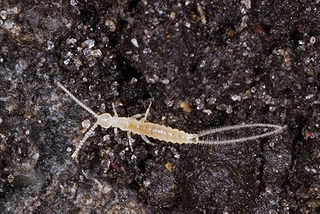
The order Diplura is one of three orders of non-insect hexapods within the class Entognatha. The name "diplura", or "two tails", refers to the characteristic pair of caudal appendages or filaments at the terminal end of the body.
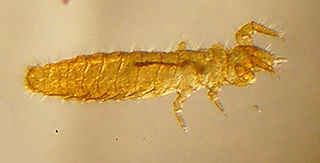
The Protura, or proturans, and sometimes nicknamed coneheads, are very small, soil-dwelling animals, so inconspicuous they were not noticed until the 20th century. The Protura constitute an order of hexapods that were previously regarded as insects, and sometimes treated as a class in their own right.
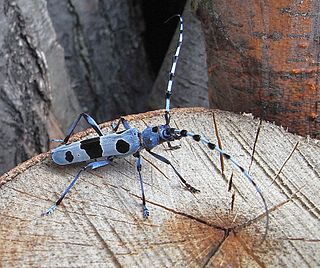
Antennae, sometimes referred to as "feelers", are paired appendages used for sensing in arthropods.

The Pterygota are a subclass of insects that includes all winged insects and the orders that are secondarily wingless.
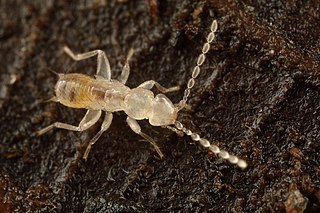
The insect order Zoraptera, commonly known as angel insects, contains small and soft bodied insects with two forms: winged with wings sheddable as in termites, dark and with eyes (compound) and ocelli (simple); or wingless, pale and without eyes or ocelli. They have a characteristic nine-segmented beaded (moniliform) antenna. They have mouthparts adapted for chewing and are mostly found under bark, in dry wood or in leaf litter.

The telson is the hindmost division of the body of an arthropod. Depending on the definition, the telson is either considered to be the final segment of the arthropod body, or an additional division that is not a true segment on account of not arising in the embryo from teloblast areas as other segments. It never carries any appendages, but a forked "tail" called the caudal furca may be present. The shape and composition of the telson differs between arthropod groups.

The name Apterygota is sometimes applied to a former subclass of small, agile insects, distinguished from other insects by their lack of wings in the present and in their evolutionary history; notable examples are the silverfish, the firebrat, and the jumping bristletails. Their first known occurrence in the fossil record is during the Devonian period, 417–354 million years ago. The group Apterygota is not a clade; it is paraphyletic, and not recognized in modern classification schemes. As defined, the group contains two separate clades of wingless insects: Archaeognatha comprises jumping bristletails, while Zygentoma comprises silverfish and firebrats. The Zygentoma are in the clade Dicondylia with winged insects, a clade that includes all other insects, while Archaeognatha is sister to this lineage.

The Archaeognatha are an order of apterygotes, known by various common names such as jumping bristletails. Among extant insect taxa they are some of the most evolutionarily primitive; they appeared in the Middle Devonian period at about the same time as the arachnids. Specimens that closely resemble extant species have been found as both body and trace fossils in strata from the remainder of the Paleozoic Era and more recent periods. For historical reasons an alternative name for the order is Microcoryphia.
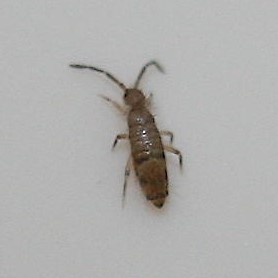
Entomobryidae, sometimes called "slender springtails", is a family of springtails characterised by having an enlarged fourth abdominal segment and a well-developed furcula. Species in this family may be heavily scaled and can be very colourful. The scale-less Entomobryidae are commonly caught in pitfall traps around the planet, and also occur in canopy faunas high up in trees. There are more than 1700 described species in Entomobryidae.
The arthropod leg is a form of jointed appendage of arthropods, usually used for walking. Many of the terms used for arthropod leg segments are of Latin origin, and may be confused with terms for bones: coxa, trochanter, femur, tibia, tarsus, ischium, metatarsus, carpus, dactylus, patella.

This glossary of entomology describes terms used in the formal study of insect species by entomologists.

The furcula, or furca is a forked, tail-like appendage. It is present in most species of springtails, and in them it is attached ventrally to the fourth abdominal segment. The organ most often is present in species of Collembola that lives in the upper soil layers where it is used for jumping to avoid predators. While at rest, it is retracted under the abdomen and held there by a structure variously called the retinaculum or hamula, which in turn is located beneath the third abdominal segment. When the furcula escapes from retinaculum, it swings downwards and hits the substrate, propelling the springtail into the air. The animal does not use this mechanism for ordinary locomotion, but only for escaping from predators or severe stress.
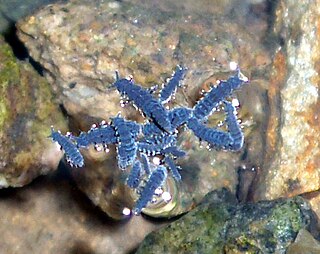
Anurida maritima, the seashore springtail, is a cosmopolitan collembolan of the intertidal zone. It is often found in aggregations of up to several hundred on the surface of rock-pools.

The order Poduromorpha is one of the three main groups of springtails (Collembola), tiny hexapods related to insects. This group was formerly treated as a superfamily Poduroidea.
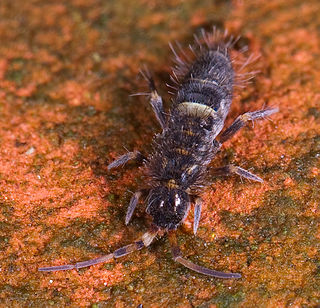
Springtails (Collembola) form the largest of the three lineages of modern hexapods that are no longer considered insects. Although the three orders are sometimes grouped together in a class called Entognatha because they have internal mouthparts, they do not appear to be any more closely related to one another than they are to all insects, which have external mouthparts.

Insect morphology is the study and description of the physical form of insects. The terminology used to describe insects is similar to that used for other arthropods due to their shared evolutionary history. Three physical features separate insects from other arthropods: they have a body divided into three regions, three pairs of legs, and mouthparts located outside of the head capsule. This position of the mouthparts divides them from their closest relatives, the non-insect hexapods, which include Protura, Diplura, and Collembola.

Orchesella cincta is a species of springtail present in North America and Europe. They average 4 millimetres (0.16 in) in length, which is extremely large as most springtails don’t grow past 1 millimetre. The specific name cincta means "belted" and refers to the distinctive colouration of the third abdominal segment.
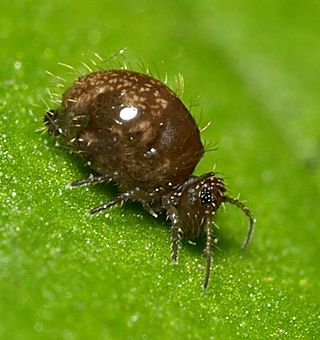
Allacma fusca is a species of springtail. This species is endemic to western areas of Continental Europe and the British Isles, where it lives in the surface layers of the soil in moist habitats such as among leaf litter.

The subphylum Hexapoda or hexapods comprises the largest clade of arthropods and includes most of the extant arthropod species. It includes the crown group class Insecta, as well as the much smaller class Entognatha, which includes three groups of wingless arthropods that were once considered insects: Collembola (springtails), Protura (coneheads) and Diplura. The insects and springtails are very abundant and are some of the most important pollinators, basal consumers, scavengers/detritivores and micropredators in terrestrial environments.



















